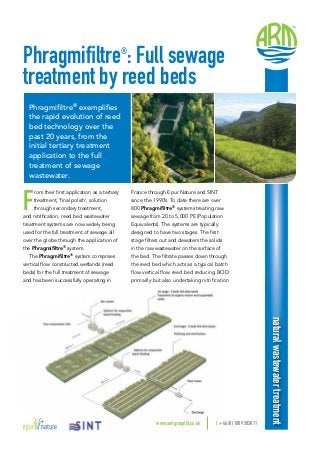
ARM-phragm Technology specific LR
- 1. Phragmifiltre® : Full sewage treatment by reed beds Phragmifiltre® exemplifies the rapid evolution of reed bed technology over the past 20 years, from the initial tertiary treatment application to the full treatment of sewage wastewater. naturalwastewatertreatment France through Epur Nature and SINT since the 1990’s. To date there are over 800 Phragmifiltre® systems treating raw sewage from 20 to 5,000 PE (Population Equivalents). The systems are typically designed to have two stages. The first stage filters out and dewaters the solids in the raw wastewater on the surface of the bed. The filtrate passes down through the reed bed which acts as a typical batch flow vertical flow reed bed reducing BOD primarily but also undertaking nitrification F rom their first application as a tertiary treatment, ‘final polish’, solution through secondary treatment, and nitrification, reed bed wastewater treatment systems are now widely being used for the full treatment of sewage all over the globe through the application of the Phragmifiltre® system. The Phragmifiltre® system comprises vertical flow constructed wetlands (reed beds) for the full treatment of sewage and has been successfully operating in www.armgroupltd.co.uk t. +44 (0) 1889 583811
- 2. naturalwastewatertreatment www.armgroupltd.co.uk t. +44 (0) 1889 583811 of ammonia. The second stage vertical flow beds provide additional BOD reduction and completes nitrification of ammonia prior to discharge. Wastewater, is fed to each bed in rotation thereby allowing all the beds to have a rest period. The use, where possible, of siphon technology for dosing both stages minimises, or even eliminates, power requirements. In the past the UK sewage treatment industry has tended to use constructed wetlands at the back end of the works as a sticking plaster solution for upstream process deterioration. The recent adoption of Phragmifiltre® by a major UK Water Company signifies a major step change in thinking and indicates recognition of the TOTEX benefits. Conventional sewage treatment works (STW) generate sludges which have to be taken from small rural works to larger STW for treatment. Phragmifiltre® stores and composts sludge on site and therefore no tanker costs (opex) and no roadways (capex) are required. Phragmifiltre® also provides wildlife habitats that conventional STW do not. Conventional STW are hazardous areas and can be vulnerable to vandalism, they need security fencing around the whole site (capex). Phragmifiltre® only requires security fencing around a few chambers for safety. Conventional STW require weekly operator visits, compared to Phragmifiltre® which requires monthly visits (opex). Phragmifiltre® constructed wetlands are an ideal replacement for aging STW and an environmentally attractive, low totex option for new developments. There is potential for this technology to be aligned with other intensive reed bed treatment technologies such as Forced Bed AerationTM to enhance treatment capabilities further if required. The summary benefits of Phragmifiltre® are: • Full primary, secondary and tertiary sewage treatment by reed beds. • Proven robustness with high tolerance of temporary hydraulic overloading. • Low to zero energy consumption • Integrated sludge treatment, therefore no tankering and associated access features required. • Simple operation • Low cost operation • Excellent integration into the landscape and no nuisance such as odours or noise. ARM Ltd in association with Epur Nature and SINT in France are proud to be bringing this technology to the UK and happy to supply further information on request. Inlet concentration (mg/L) Outlet concentration (mg/L) Removal efficiencies (%) Mean SD Mean SD Mean SD COD 651 282 50 29 92 7 BOD5 291 140 8 9 97 3 SS 242 133 8 6 97 3 TKN 56 34 7 12 90 12 TP 7 4 6 3 32 25 Typical treatment performance data from 70 plants